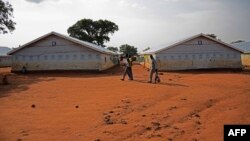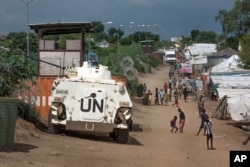An unprecedented number of refugees from South Sudan have been streaming into Uganda since fighting broke out in Juba last month. In some border towns, refugees now outnumber local residents. Humanitarian agencies working at the border say more assistance is urgently needed.
In the past month, about 70,000 South Sudanese have sought refuge in Uganda. Many arrive malnourished and in desperate need of medical care. Aid agencies have swung into emergency mode trying to provide clean water, food, sanitation and shelter at overcrowded refugee intake centers.
Catherine Ntabadde with the U.N. Children’s Fund (UNICEF) said they've had to expand quickly to keep possible disease outbreaks at bay. She said having 4,000 people or even just 1,000 in one place can be challenging in terms of hygiene and water.
"We've been able to construct temporary bathing shelters for people to use, temporary latrines — these are at 10," she said. 'We've also installed a water treatment system to help ease on the access of safe water... the critical thing that we are enforcing is to sensitize this population about good hygiene.”
Budget shortfalls, however, could hinder this work. According to the Norwegian Refugee Council — NRC — aid agencies have only received 20 percent of the funds they need to adequately handle the current flow of refugees.
And with tensions still high in Juba, many refugees have no imminent plans to return home.
40,000 refugees in holding centers
Jesse Kamstra, who works with the Lutheran World Federation, said there are currently about 40,000 refugees in holding centers waiting to be moved.
"And those had to be constructed on an ad-hoc basis," said Kamstra. "In all my career, I've never had a situation where we were receiving over 8,000 refugees a day and international media had not picked up on it, and that's something that's surprised us all. ... So no international attention, no additional funds and that's what happens.”
Uganda hosts just over a half million refugees, mostly from the DRC and South Sudan.
Although aid agencies praise the Ugandan government's welcoming approach, in some areas like Adjumani district, South Sudanese now outnumber Ugandan citizens. This has caused a rise in community tension.
Stephen Obitre, a Ugandan living in Arua told VOA Ugandans must welcome refugees and learn to coexist with them. However, he said the influx hasn't been easy.
“This influx," he added, "has caused massive environmental degradation, in Arua, Yumbe and Adjumani because a lot of vegetation is just being cleared to settle these refugees. People are being displaced, like cattle grazers, without their consent."
The government has opened a new settlement camp that can house 100,000 refugees in a bid to ease the burden in Adjumani.
Yet without adequate funds, the new camp does not have the infrastructure it needs and clean water access. Aid agencies say emergency operations are far from over.
The NRC says 80,000 more refugees from South Sudan are expected to arrive by year’s end.










